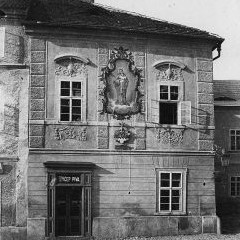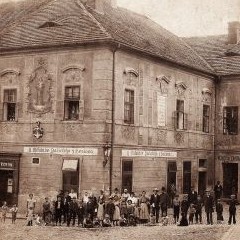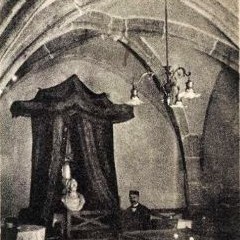How the House was used in its history
Although the House is mentioned already in the first preserved munucipal book from the years 1426 – 1489, its first significant restoration was carried out as late as the period following the year 1500, resp. before 1506.
At that time the House was called “Bishop´s house” because the councillors of Kutna Hora had it reconstructed for Filip Villanuova Sidonsky, consecrating bishop of the Utraquist Church, who stayed here from Christmas of 1506 till his death in October 1507. In this period, the groin vault of the back chamber and other Gothic elements of the House were created (this space most likely served as the bishop´s private chapel).
The demanding re-construction of the House carried out in that period also involved selection of the building guild that constructed the vault of the chapel resting on the supports adjacent to the walls, which is characteristic for the re-construction of the Hradek (Fortress) in Kutna Hora about 1500. In the course of the re-construction the House was also provided with the present superstructure masonry above the ground floor with brick-vaulted arcade, large windows in the facade and probably also an arch bay in the first floor of the western facade supported with three wooden brackets.
16th and 18th centuries
In 1536 the House was bought by Ondrej Krivolacek, called Dacicky. In 1555 his wife Dorota of Prachnany gave birth to their son Mikulas Dacicky in this House. A significant increase of the selling price of the House in the second half of the 16th century indicated its Renaissance reconstruction, in which the windows of the north front were made smaller and the coating of the House was completely covered with letter graffiti.
Unlike almost half of the Kutna Hora houses, the House did not probably become dilapidated during the Thirty-Year War – its other reconstruction was carried out at the end of the 17th century and, above all, in the third quarter of the 18th century. At that time the appearances of the House were changed with a new facade, its Gothic arch bay was removed, the window openings were aligned according to Baroque symmetry and the walls were provided with stucco decoration.
19th century
In 1800, the original lane between the houses No. 41 and 42 was vaulted within the framework of the first classicist re-construction of the House as documented by the first plan of the town´s ground plot dating from 1813 by F. J. Schaffus. The second, more remarkable classicist re-construction , was carried out between 1841 – 1842. The complete ceiling structure of the ground and first floors was removed. Also the disposition of the House was significantly changed, which involved that two flats for rent were set up and the arcades were walled up. Some ten years later the roof structure was completely removed in accordance with a plan preserved up to now.
20th century
The twentieth century meant rather a devastation of the House. Firstly the House served as the main part of the restaurant called “U Sasku”. Afterwards the House was nationalized and became a property of the Kutna Hora town. In the seventies the House was, inconsiderately, adapted for dwelling purposes and also a workshop on the ground floor was set up.
Yet there is no doubt that the Dacicky House belongs among the most significant buildings of the Kutna Hora town inscribed on the list of UNESCO cultural and natural heritage.
The House is important for its well-preserved late-Gothic core and High-Baroque facade with remainders of Gothic elements, its body constituting a corner of the Komensky Square and Rejsek Street. From the viewpoint of history and culture, the House is important as the seat of an Utraquist bishop and the birthplace of the chronicler Mikulas Dacicky of Heslov.


